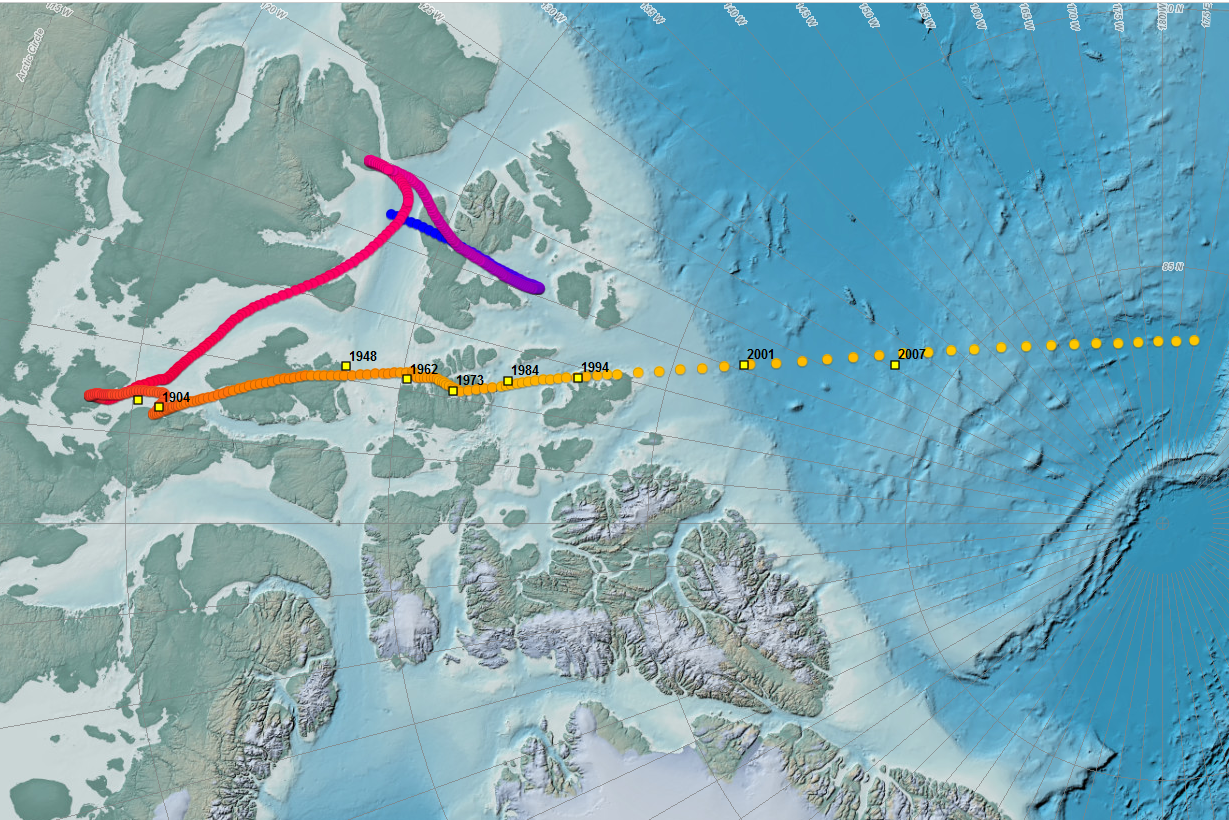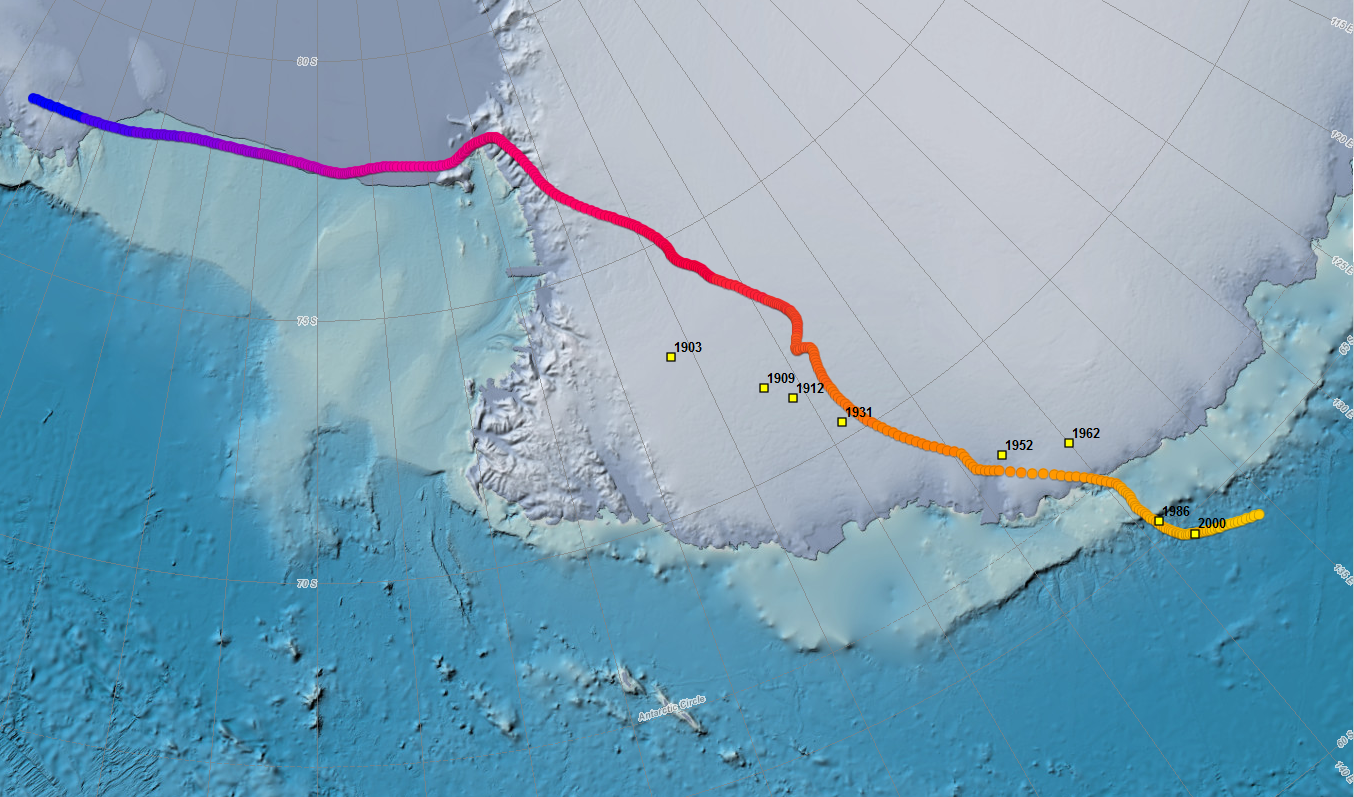From Sputnik News comes the headline, Earth Enters Unknown as Magnetic North Pole Continues Push Toward Russia, Crosses Greenwich Meridian.
The BGS and the US National Centers for Environmental Information has released a new update to the World Magnetic Model this week, confirming that the magnetic north pole, whose coordinates are crucial for the navigation systems used by governments, militaries and a slew of civilian applications, is continuing its push toward Siberia.This is the second update to the official magnetic model this year, after February's emergency update - the first ever issued. The magnetic north pole - which has quietly ambled about the Canadian Arctic for as long as it's been tracked - is now decisively sprinting towards eastern Russia. Interestingly, the two poles are currently tracking towards each other. The southern pole is not moving as aggressively but has a headstart - already north of Antarctica and the Antarctic Circle.
The data confirmed that this year, the magnetic north pole passed to within 390 km of the geographic North Pole, and crossed the Greenwich (prime) meridian. Compilers also confirmed that the Earth’s magnetic field is continuing to weaken, at a rate of about 5 percent every 100 years.
Scientists have been unable to do little more than speculate at the cause of the magnetic phenomena, let alone make any useful predictions.
Magnetic north, the point on the planet’s surface toward which your conventional compass points, is created by the churning of molten metal in Earth’s core, which creates huge electrical currents to produce the magnetic field.The theory that magnetic fields are caused by deep, circulating currents of charged magma is another one of those assumptions of which there is no direct evidence - as is even admitted by the interviewed geophysicist. The fluid rotation is supposedly driven by planetary rotation - which is constant - but gives way to chaotic magnetic behavior, including complete reversals of polarity. The scientist here attempts to make an analog to the atmospheric jet stream, a chaotic, oscillating system driven by stable inputs, and yet we have no evidence of the jet stream ever completely reversing direction.
Dr. Phil Livermore of Leeds University’s Institute of Geophysics recently postulated that a ‘jet stream’ of liquid iron flowing in the planet’s core could help explain shifts in the position of magnetic north, but suggested tracking the flows of this liquid iron could be difficult, “because it lies beneath 3,000 kilometres of rock.”
The "molten dynamo" theory of magnetic fields causes problems when applied to the rest of the observable celestial bodies. Of the rocky planets, only Earth has an appreciable magnetic field, and Mercury a small field. Mercury is so small that its core should no longer be hot enough for a molten core, yet Venus is very similar to Earth but much warmer and with evidence of recent volcanism but has no magnetic field at all. The moon has no magnetic field, thus no molten core, and yet the dark regions (the mares) are said to be caused by lunar volcanism, and the light cratering suggests they are relatively young. Similarly, some of the moons of Jupiter and Saturn have strong magnetic fields, yet are so small they should have cooled off by now. Astrophysicists attribute the internal heating to tidal forces but, like dark matter, it's something they apply where needed when observations don't match expectations. All the gas giants have powerful magnetic fields, especially Jupiter. If humans were able to see magnetospheres directly, then Jupiter would appear much larger than the moon in the night sky. Scientists have to conjure up other theories to explain those magnetic fields, such as rotating clouds of metallic hydrogen. Suffice it to say, planetary magnetism remains a mystery to everyone. Even the electric universe people don't offer an explanation as to why Earth has a magnetic field but not Venus.
The erratic motions aren't just a curiosity, and the concern is not limited to just navigation interests.
Scientists have previously expressed concerns about the fluctuations in the magnetic north pole and its possible impact on the magnetic field protecting Earth. Without the field, Earth would be left vulnerable to solar flares, which could cause damage to everything from spacecraft to power grids. Even with the magnetic field intact, the planet remains vulnerable. In 2011, the US National Academy of Sciences calculated that a repeat of a solar storm like the one which hit the planet in 1859 could cause as much as $2 trillion in initial damage, and take a decade to repair.Reversals are actually more frequent than the 800,000-year cycle mentioned here, but those are unstable, whereas the decisive flips are more rare. A well-studied magnetic excursion from 41,000 years ago - the Laschamp event - featured a magnetic field only 5% as strong as our current magnetic field. Such a weak field would have offered little protection against space radiation and would have posed a threat to life even back then. Our technological society would be completely vulnerable in such a scenario. As the magnetic field weakens, the odds of a solar flare capable of destroying our electric grid increases.
Furthermore, a weakened magnetic field may lead to a potentially cataclysmic process scientists call a “geomagnetic reversal,” in which the Earth’s north and south poles effectively switch places. The last such flip is estimated to have taken place about 800,000 years ago, and some scientists believe that another may be due soon, even though such an event could take centuries to complete.
The last known flip was 12,000 years ago. Ben Davidson of suspicious0bservers makes the case that there is a 12,000-year "disaster cycle" on Earth - and we are about due for another. Specifically, he alleges that magnetic flips cause the Earth's crust to disconnect from the mantle and slip a significant distance, causing unimaginable destruction and driving the oceans up onto the landmasses. It's a little out there, but there is at least as much evidence of the historical events as there is of the conventional theory of planetary magnetism. Davidson takes it seriously enough that he moved his family to the region of the US most likely to survive such a cataclysm.
Even if you choose not to indulge such predictions of doom, keep in mind that even a highly sober analysis leaves much room for concern. The DOD estimates that losing the power grid to an EMP blast would kill 90% of Americans within 18 months. So if Davidson's theory sounds outlandish, it doesn't greatly extend the potential death count over what is conventionally regarded as our risk to such events. Further, a tale of epic flooding around 12,000 years ago doesn't sound that outlandish, does it? Those of the Abrahamic religions (slightly over half the Earth) profess a belief that God unleashed a devastating global flood in response to widespread human wickedness. Scientists also point to evidence for flooding around that time (here, here, and here).
If you are part of the half of the world that believes God unleashed a devastating flood to punish humanity, you also may be re-assured, since He made a covenant to never again destroy the world by flood. However, recall the symbol that was given to us of that covenant.
Consider the Noahic covenant to be broken. Man the globe over has made it quite clear what it thinks about God and his symbols. Some say that the covenant is unconditional and can't be broken by man. Still, it may be time to consider making a move to higher ground, or perhaps building a very large wooden boat.



No comments:
Post a Comment